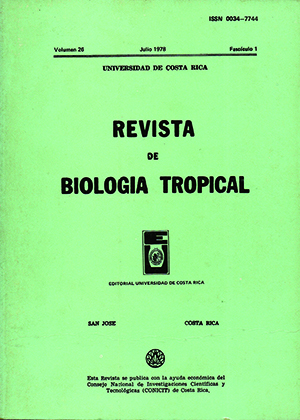Resumen
Fueron estudiados algunos aspectos biológicos del rotífero Asplanchna sp. del Brasil, mantenidos en el laboratorio, y fue determinada la curva media de desarrollo, estableciéndose las conexiones de esa curva con el tiempo medio de generación de las hembras amícticas, que fue de cerca de 22 horas. De este modo el primer descendiente de una hembra amíctica nació, en promedio, casi al final de su período de crecimiento activo.
También fueron hechos estudios sobre la longevidad de las hembras amícticas y estudios comparativos sobre la fecundidad entre éstas y entre las mícticas. Las hembras amícticas presentaron una longevidad media de 90,30 horas y una fecundidad media de 17 descendientes. Por otro lado, una hembra míctica produjo, en promedio, 4 huevos cuando fecundada, o 13 machos en ausencia de fecundación.
Citas
Birky, C. W., Jr. 1964. Studies on the physiology and genetics of the rotifer, Asplanchna. I. Methods and physiology. J. Exp. Zool., 155: 273-292.
Birky, C. W.; Jr. 1965. Studies on the physiology and genetics of the rotifer, Asplanchna. II. The genic basis of a case of male sterility. J. Exp. Zool., 158: 349-356.
Birky, C. W., Jr. 1967. Studies on the physiology and genetics of the rotifer, A splanchna. III. Results of outcr.ossing, selfmg and selection. J. Exp. Zool., 164: 105-116.
Birky, C. W., Jr. 1968. The developmental genetics of polymorphism in the rotifer. Asplanchna. I. Dietary vitamin E control of mitosis and morphogenesis in embiyos. J. Exp. Zool., 169: 205-210.
Birky, C. W., Jr. 1969. The developmental genetics of polymorphism in the rotifer. Asplanchna. III. Quantitative modification of developmental responses to vitamin E, by the genome, physiological state, and population density of responding females. J. Exp. Zool., 170: 437-448.
Birky, C. W., Jr., & J. J. Gilbert 1971. Parthenogenesis in rotifers: the control of sexual and asexual reproduction. Amer. Zool., 11: 245-266.
Birky, C. W., Jr., & J. J. Gilbert 1972. Vitamin E as an extrinsic and intrinsic signal controlling development in the rotifer Asplanchna: uptake, transmission and localization of eH) alpha-tocopherol. J. Embriol. Exp. Morph., 27: 103- 120.
Buchner, H., H. Kiechle, & P. Harnm 1965. Zur fortpflanzungsbiologie der riidertiere. Naturwissenschaften, 52: 352.
Buchner, H., C. Mutschler, & H. Kiechle 1967. Die determinatio'n der miinnchen and dauereiproduktion bei Asplanchna sieboldi. Biol. Zbl., 86: 599-621.
Gi1bert, J. J. 1968. Dietary control of sexuality in the rotifer Asplanchna brightwelli Gosse. Physiol. Zool., 41: 14-43.
Gilbert, J. J., & G. A. Thompson 196 8. Alpha-tocopherol control of sexuality and polymorphism in the rotifer Asplanchna. Science, 159: 734-738.
Lewontin, R. C. 1965. Selection for colonizing ability, p. 77-91. In The genetics of colonizing species. New York, Academic Press.
Sonneborn, T. M. 1950. Methods in the general biology and genetics of Paramecium aurelia. J. Exp. Zool. , 113: 87-147.
##plugins.facebook.comentarios##

Esta obra está bajo una licencia internacional Creative Commons Atribución 4.0.
Derechos de autor 1978 Revista de Biología Tropical


